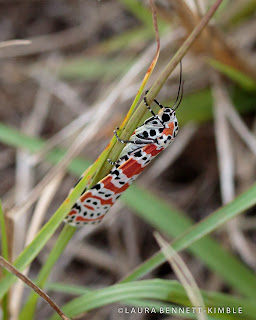National Moth Week: Ornate Bella Moth (Utetheisa ornatrix)
 |
| Ornate Bella Moth (Utetheisa ornatrix) © Laura Bennett-Kimble |
The dainty Ornate Bella moth has surprised more than one casual observer with a flash of its distinct pink wings—typically visible only when in flight. In addition, markings also can boast yellow, orange, black and white variations, which make it pretty flashy in the moth world.
This lovely species is a small one, with a wingspan of only 1.25 to 1.75 inches. And when it folds its wings tightly against a blade of grass, you’ll be hard pressed to spot it. Fortunately, the Bella moth isn’t nocturnal like many of its moth relatives, so you’ve got a better chance of seeing it flitting through the grass in the daylight.
Host plants for the moth’s caterpillars are both native (four species) and non-native (10 species) Crotalaria, known as rabbit bells, as well as rattlebox for the rattling sound of ripened seed pods. This leads to another common name for the Bella moth: rattlebox moth.
Interestingly, “because most of [Florida’s] common Crotalarias are introduced weedy species and toxic to cattle, the Ornate Bella moth plays a beneficial role by eating their seeds and suppressing their reproduction,” according to University of Florida’s IFAS.
That diet provides the species a protective defense, because Crotalaria plants and seeds contain pyrrolizidine alkaloids that the Bella moth caterpillars ingest. The moths are subsequently poisonous at every stage of the life cycle, which keeps potential predators, such as spiders, at bay.
While Ornate Bella moths can be found as far north as New England and west into Arizona and Nebraska, they are more commonly found in southern states and even as far south as South America.
If you’ve been lucky enough to snap a photo or two of one of these small beauties, consider sharing it in the iNaturalist National Moth Week citizen science project. National Moth Week events are being organized around the globe, too, and online registration is available for group and individual activities.
by Laura Bennett-Kimble of Passionflower Chapter, edited by Valerie Anderson



Comments